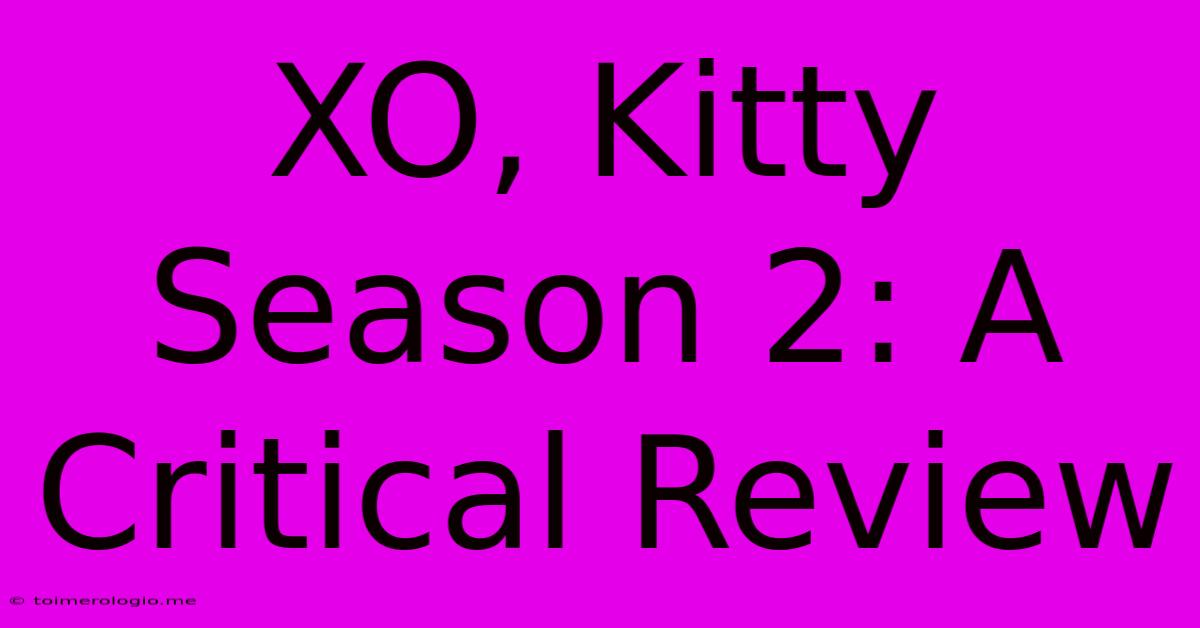XO, Kitty Season 2: A Critical Review

Discover more detailed and exciting information on our website. Click the link below to start your adventure: Visit Best Website toimerologio.me. Don't miss out!
Table of Contents
XO, Kitty Season 2: A Critical Review
Netflix's XO, Kitty, the spin-off of the beloved To All the Boys film trilogy, returned for a second season, promising more drama, romance, and cultural exploration in the vibrant backdrop of Korea. While Season 1 charmed viewers with its lightheartedness and relatable coming-of-age story, Season 2 takes a bolder, more complex approach, resulting in a mixed bag of successes and shortcomings. This review delves into the highs and lows of XO, Kitty's second season, analyzing its character development, narrative choices, and overall impact.
A Deeper Dive into Relationships: The Heart of Season 2
Season 2 significantly expands on the romantic entanglements introduced in the first season. Kitty Song Covey, our protagonist, finds herself navigating a complicated web of feelings, juggling her relationship with Dae and her undeniable chemistry with Min Ho. This exploration of polyamory and non-monogamous relationships is a bold move for a young adult series, pushing beyond the typical high school romance tropes. However, the execution feels rushed at times, leaving some relationships underdeveloped and the emotional consequences unexplored.
The Dae-Kitty Dynamic: A Shifting Landscape
The relationship between Kitty and Dae, initially the central focus, undergoes a significant transformation. Their initial bliss is tested by distance, misunderstandings, and the introduction of other romantic interests. While the portrayal of relationship challenges is realistic, the constant back-and-forth between Kitty and Dae feels repetitive and ultimately unsatisfying. The season doesn't quite offer the resolution viewers crave, leaving their relationship hanging in the balance.
The Min Ho-Kitty Connection: A Compelling Complexity
Kitty's burgeoning feelings for Min Ho introduce a significant layer of complexity. Their connection is undeniably captivating, showcasing a mature and emotionally intelligent dynamic often missing from similar teen dramas. The exploration of their shared past trauma and personal struggles adds depth and vulnerability to their relationship, making it one of the season's strongest aspects. However, the show treads carefully around the ethical implications of their developing feelings, leaving much open to interpretation.
Yuri and Alex: Beyond the Typical Trope
The secondary relationship between Yuri and Alex provides a refreshing contrast to the central romantic conflicts. Their journey, characterized by open communication and mutual respect, offers a more positive portrayal of LGBTQ+ relationships. This is a significant win for representation in young adult programming, showcasing a healthy, supportive partnership that doesn't shy away from the complexities of long-distance relationships.
Character Development: Hit and Miss
Season 2 strives for deeper character development, pushing the characters beyond the initial archetypes established in the first season. However, the execution is uneven.
Kitty's Growth: A Work in Progress
Kitty's journey is arguably the central focus, and her growth throughout the season is a significant arc. We witness her grappling with difficult choices, navigating heartbreak, and confronting her own insecurities. This portrayal of a young woman navigating complex emotions is both relatable and engaging. However, some viewers may find her impulsive decision-making frustrating, questioning the maturity of her actions.
Supporting Characters: Underexplored Potential
While some supporting characters, like Yuri and Alex, receive satisfying development, others feel underutilized. The potential of certain characters is hinted at but never fully explored, leaving viewers wanting more depth and background. This lack of consistent development weakens the overall narrative, detracting from the impact of the central conflict.
Cultural Representation: A Mixed Bag
XO, Kitty aims to showcase Korean culture authentically, and in some aspects, it succeeds. The portrayal of family dynamics, social customs, and daily life in Korea feels genuine and respectful. However, some aspects of the cultural representation remain superficial, relying on stereotypes rather than deeper understanding. While the effort to represent Korean culture is commendable, a more nuanced approach could elevate the series further.
Narrative Structure: A Flawed but Engaging Plot
The narrative structure of Season 2 is a double-edged sword. The season is filled with twists, turns, and surprising revelations that keep viewers engaged. However, the pacing feels uneven at times, with certain plotlines rushed while others drag on unnecessarily. The constant shifting between romantic relationships can feel disorienting, leaving the audience struggling to connect emotionally with the central conflicts.
The Verdict: A Season of Ups and Downs
XO, Kitty Season 2 is a complex, emotionally charged season that delivers both thrilling moments and frustrating shortcomings. The exploration of complex relationships, particularly the nuanced portrayal of polyamory, is commendable and pushes the boundaries of typical teen dramas. However, the uneven pacing, under-developed supporting characters, and occasionally superficial cultural representation hinder its overall impact. While the season leaves viewers craving closure and hoping for a third season, it serves as a reminder that even the most promising beginnings can fall short of their potential. The bold choices made in Season 2, however flawed, suggest a promising future for the series if the creators address the narrative and character development shortcomings. The exploration of complex themes related to love, identity, and cultural understanding deserves credit. However, tightening the narrative focus and deepening the character arcs will be crucial for future seasons to reach their full potential.

Thank you for visiting our website wich cover about XO, Kitty Season 2: A Critical Review. We hope the information provided has been useful to you. Feel free to contact us if you have any questions or need further assistance. See you next time and dont miss to bookmark.
Also read the following articles
| Article Title | Date |
|---|---|
| Aaliyah Barbie Leather Look Unveiled | Jan 19, 2025 |
| Cavs Thunder Game January 16th Preview | Jan 19, 2025 |
| Ashley Moody Key Facts And Role | Jan 19, 2025 |
| Aaliyah Barbie A Birthday Celebration | Jan 19, 2025 |
| One Of Them Days Comedy With Keke Palmer | Jan 19, 2025 |
